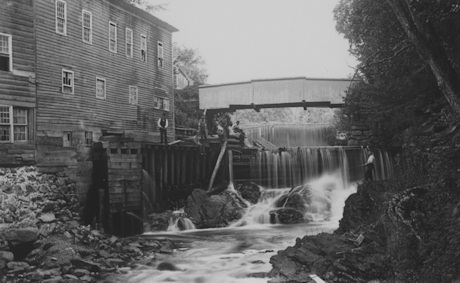csoy_apr2011
April 2011 Update - Now that the warmer weather is here, I'm sure many of you are ready to get out and visit some bridges. As I write this, (April 14th), the last bits of snow are receding from our yard and we are making plans for a couple spring and summer excursions. If all goes as planned, we will be joining the Burr Society for their
safari in Virginia and West Virginia during the first weekend in June. We are looking forward to seeing a
few of you there.
As I mentioned in my previous article, Arcadia Publishing has offered me the opportunity to prepare a
book in their Images of America series about the covered bridges of Connecticut and Rhode Island.
During the winter, we made a few visits to historical societies and libraries in both states and met lots of
great people along the way. The book is now complete and in production. It will probably be released
around September. I expect to know the exact date in early June.
One of the people we encountered was Peg Giles of Granby, Connecticut. Peg's grandfather, Frank
DeMars, was a photographer who traveled around northwestern Connecticut and southwestern
Massachusetts in the early 1900s. He took a large number of photographs himself and also bought other
people's collections. Peg has scanned the thousands of glass plate negatives and has made them
available through her website, www.demarsimages.com. There is something for everyone in Mr. DeMars'
collection; bridges, buildings, factories, local scenery, portraits, and much more. Some of the bridge
pictures from that collection have been included in the book. Northwestern Connecticut was home to many pony truss bridges. They were especially popular along the upper reaches of the Farmington River's east and west branches and their tributaries. The bridge pictured here, from the DeMars Collection, crossed the Still River at Robertsville, a community within the town of Colebrook.
The first bridge at this location was built in the late 1770s by a man named Calhoon, who was working for
Richard Smith, the land owner and owner of the forge, which stood adjacent to and upstream from the
right-hand bridge abutment. Smith was an Englishman who also operated a furnace in Salisbury. The
pictured bridge was likely built in the late 1800s. It has been replaced at least twice since then. The
current concrete structure was built after the August 1955 flood.
Immediately to the east of the bridge was the three-story Union Chair Company. The site was operated
as a wood turning shop by Samuel Roberts from about 1800 until it was sold to his competitors, Hitchcock
and Alvord of Riverton, in 1840. The business changed hands again and opened under the name of the
Union Chair factory in 1850. It was operated by three men from Hitchcock's chair shop in Riverton.
Chairs were loaded onto wagons and sold door to door throughout Connecticut and as far as Rhode
Island and New York. One of the factory's drivers was Peter DeMars, father of Frank DeMars. The
factory went out of business in the 1890s. Only a portion of the foundation remains.
I would like to thank Robert Grigg, Colebrook Town Historian, for providing information about the bridge
and chair factory. Some of the material was based on research done by Henry Hart Vining.
For information about other former covered bridges, visit our website at www.lostbridges.org. If you have
information or pictures of the former bridges in your area, please share that with us. There is still a vast
amount of territory to cover and any assistance will be greatly appreciated. Email is usually the most
effective way to contact me - bill@lostbridges.org.
 Return to First Page
Return to First Page
 Return to Yesteryear Index
Return to Yesteryear Index

by Bill Caswell

 Joe Nelson, P.O Box 267, Jericho, VT 05465-0267
This file posted 04/17/2011
Joe Nelson, P.O Box 267, Jericho, VT 05465-0267
This file posted 04/17/2011